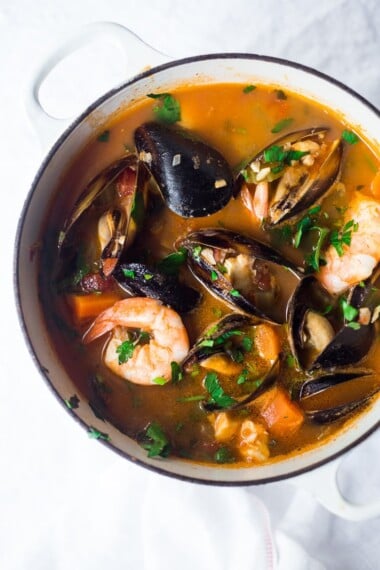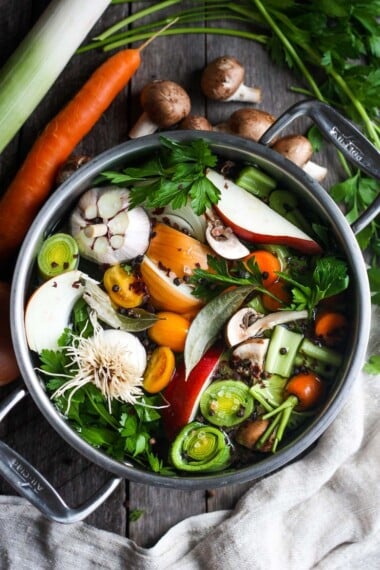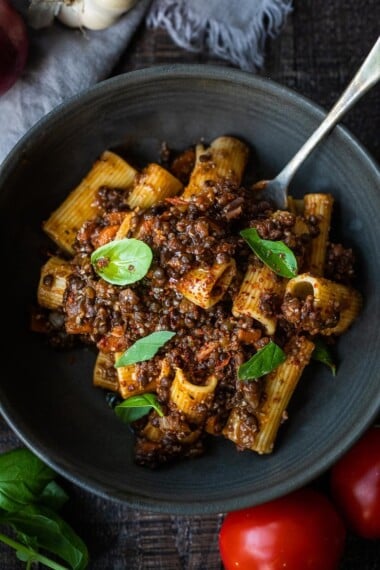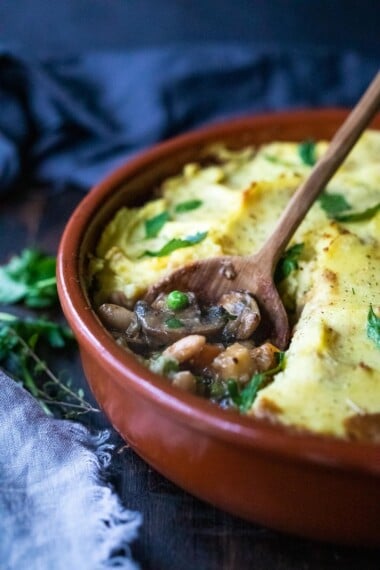This post may contain affiliate links. Read my full disclosure policy.
This Kimchi Recipe is quick and easy and takes only 30 minutes of hands-on time before mother nature takes over! Full of healthy, gut-healing probiotics, the benefits of eating kimchi are endless. This authentic kimchi is vegan-adaptable, gluten-free and can be made as spicy or as mild as you like! Includes a video.
Love cabbage? Check out our 26+ Amazing Cabbage Recipes!
 We are never in as much joy as when we are engaged in the well-being of others. ~ Adyashanti
We are never in as much joy as when we are engaged in the well-being of others. ~ Adyashanti
What is Kimchi?
Kimchi is essentially Korean fermented cabbage -similar to sauerkraut but seasoned with garlic, ginger & Korean chilies. Kimchi is the heart and soul of Korean cooking, and delicious with so many things!
But the best thing about Kimchi? Kimchi is alive! Full of living, healthy good bacteria, or probiotics that support the gut, boost immunity, energize the body, and aid digestion, it is believed to fight cancer, lower cholesterol and regulate blood sugar.
HOW TO MAKE KIMCHI| 60-second video
Why I love this kimchi Recipe
This kimchi is made with simple ingredients, is highly adaptable, and is relatively authentic. It’s easy and forgiving!

What does Kimchi Taste like?
Kimchi tastes sour, tangy, salty, spicy, and pungent! It’s similar to sauerkraut in that it is fermented cabbage, but kimchi is packed with flavor, umami and a little (or a lot) of heat! The fermentation process is what gives kimchi its sour flavor.
Why eat Kimchi?
Because kimchi is naturally fermented, it is full of healthy bacteria, good for the gut and good for immunity. But besides being a healthy thing to incorporate into our diets, Kimchi adds so much flavor to things we are already making at home!

What you’ll need
This easy kimchi recipe makes enough to fill a large two-quart jar (about 8 cups).
- One large Napa Cabbage
- Ginger
- Garlic
- Scallions
- Diakon
- Shrimp paste , fish sauce, dried shrimp or miso paste (vegan version)
- Korean Chili Flakes called Gochugaru (or feel free to sub Gochujang)
- optional: glutenous rice flour (to thicken)
I use Korean Chili Flakes called “Gochugaru” in this recipe vs. Korean fermented Chili Paste called “Gochujang“.
Feel free to use Gochujang if you please or if you have it on hand. (The reason I decided not to use the Gochujang is Gochujang sometimes contains other processed food ingredients- so I went a cleaner route today.) Totally up to you.
You can find Gochugaru at most Asian Markets or order online. Add other veggies to the mix like matchstick daikon radish or carrots.
Vegan Kimchi optionS
- Fish sauce adds depth but you can leave this out- and use soy sauce, miso paste or vegan fish sauce.
- Use miso paste to add depth, flavor and also more probiotics- especially if going vegan.
- Gluten-free version, liquid aminos work well too.
Kimchi Variations
- Like so many things, there are so many variations to kimchi, and people have their own personal preferences. I just wanted to provide you with a starting point, and I’m sure you will adapt to your own tastes!
- Some people add sugar, some don’t.
- Some add carrots, some don’t.
- And, to be clear this is not the exact recipe from the mother of the bride, but a little simplified. The ingredients are similar (except she added dried shrimp) but I tried to make this as easy as possible.

How to make Kimchi (Step-by-Step Guide )
****See the recipe for more detailed instructions.
Step one: Save 1-2 outer leaves of cabbage and place in the fridge (you will use these later). Cut the napa cabbage into 1-inch cubes.

Step two: Place napa cabbage in a bowl and toss with 1/4 cup sea salt.

Step three: Fill the bowl with filtered water and stir, and soak the napa cabbage for 6-8 hours.
 Place plate over the napa cabbage to keep it submerged.
Place plate over the napa cabbage to keep it submerged.

Step Four: After 6- 8 hours, drain (making sure to save the brine) and rinse, pressing the liquid out.

Step Five: Make the Kimchi Paste
As I stated earlier, I prefer to use Korean Chili Flakes called “Gochugaru” vs. the Korean fermented Chili Paste called “Gochujang“. Feel free to use Gochujang if you please. Totally up to you. Either way, you will make the paste below.
Many people ask if they can use regular old chili flakes- yes, but they are much spicier!!! Gochugaru is fruitier and less spicy, so you can use more and get more flavor. You could try subbing dried Arbol Chilies if you absolutely can’t get the Korean Chili flakes – or even use fresh red chilies to make the paste.
In a food processor, make a paste with garlic, ginger, shallot, Korean chili flakes (or Gochujang) and optional fish sauce (or miso) and sugar. If you want a mild version, use half the chili flakes. The fish sauce really adds a delicious complexity and depth, but you can, of course, keep it vegan.

Step Six: Peel and cut the daikon radish (or carrot) into match sticks, about 2-3 inches long. Cut the scallions.

Step Seven: Cut the scallions into 1-2 inch pieces.

Step Eight: Combine the Kimchi. Place the drained cabbage along with the daikon, scallions and chili paste into the bowl. Massage the cabbage with gloved hands.
FYI: This is a very mild version shown below, so not very red, ( 2 tablespoons chili flakes). You can also add more chili flakes if you want it spicier – I normally add 4-6 tablespoons.

Step Nine: Pack the Kimchi.
Pack tightly into a large two-quart jar (half-gallon, 64 oz) or large crock. (Or use two, quart-sized mason jars.) You want a good two inches of space at the top to catch the flavorful liquid that will release.
TIP: I have had great success with this Fermentation Kit that has crystal weights that fit perfectly in a wide-mouth mason jar. It is so convenient for small-batch ferments. This fermentation kit includes the jars which is a great option too!

Pour a little of the brine into the jar, just to enough to cover the cabbage.

Cover with the cabbage leaf you saved, and press down. The leaf will help keep the cabbage submerged. Add a fermentation weight to keep the cabbage submerged. Cover with a lid (do not screw on tight) and place on a rimmed pan or bowl ( to collect any overflow).
Step Ten: Ferment!
Set the jar somewhere dark and cool like the basement for 3-5 days. A lower kitchen cabinet away from stove or appliances can also be a good cool spot. Check daily, pushing down the cabbage under the brine if need be. Look for signs of life.
What temperature is best to ferment Kimchi?
The ideal temperature for fermenting kimchi 60-65 degrees. 65 F is perfect! The cooler it is, the slower it will take to ferment. The warmer, the faster. The longer you ferment the tangier and softer the kimchi will get. I prefer slightly crunchy kimchi, so ideally, 3-5 days at 65F is my favorite! Going too much over 70 degrees can actually have negative effects on the flavor.
How do you know if kimchi is fermenting?
- After 3 days, tap the jar to see if any bubbles rise to the top, indicating that it is fermenting. If there is any overflow, this is also a sign of fermentation.
- Taste the kimchi for tanginess. If it tastes sour or tangy, this is a sign of fermentation.
- Continue to ferment for 2-7 more days if you want it tangier or softer, then place it the fridge, keeping in mind it will continue to ferment, albeit more slowly. Kimchi will continue to ferment in the fridge but at a much slower rate. It will develop more flavor and complexity over the next two weeks in the fridge, and the spice level will mellow with time!
How to thicken Kimchi?
If your kimchi is too watery for your taste, you can thicken it. To thicken kimchi, stir in a little glutenous rice powder. Some traditional recipes also use soybean powder.
How to store Kimchi?
Keep fermented kimchi in a 2-quart jar or crock with the lid on, pressing it down under the brine after each use. It will keep for months on end in the fridge when the kimchi is submerged below the brine….getting better and more flavorful with time!

WAYS TO USE KIMCHI:
We add kimchi to so many things! It is a huge flavor booster, and FULL of natural, gut-healing bacteria that support your microbiome, boost your mood, and bolster your immune system!
Here are a few of our favorite ways to use kimchi!
- Kimchi Fried Rice
- Kimchi Noodles
- Kimchi Burritos
- Kimchi Soup Recipe
- Seoul Bowl!
- On Buddha Bowls
- As a side dish with dinner, simply drizzled with toasted sesame oil and sesame seeds!
More healthy Fermented Foods:
- 25 Immune-Boosting Recipes!
- Simple Cultured Cabbage (Sauerkraut)
- Cucumber Kimchi Pickles!
- Fermented Hot Sauce,
- Fermented cucumbers!
- Curtido,
- Beet and Cabbage Kraut,
- Tumeric Kraut
- Sourdough Bread!
Enjoy the process of making Kimchi! Please ⭐️ rate the recipe (always appreciated) and tell us how it goes me how it goes in the comments below.
On the homefront: Many years ago now, we catered a Korean wedding. I remember meeting with the bride and groom and listening very carefully about the importance of the kimchi being served. It had to be “just right”.
Truth be told I was nervous, I had never made it back then, but the bride’s mother was kind enough to send me her personal kimchi recipe and thankfully I had time to practice it a few times before the big day.
In the end, they were happy. And wherever they are now, I hope they are still. I’ve never counted the number of weddings we’ve catered, but every so often a couple pops into my mind, most often when I’m cooking, and I can’t help but give them a little nod and wish them well.
xoxo

Kimchi: A Beginner’s Guide
- Prep Time: 30 minutes
- Cook Time: 4 days
- Total Time: 72 hours 30 minutes
- Yield: 8 cups 1x
- Category: fermented, sides, preserved
- Method: fermented
- Cuisine: Korean
- Diet: Vegan
Description
This Kimchi Recipe is quick and easy and takes only 30 minutes of hands-on time before mother nature takes over! Full of healthy, gut-healing probiotics, the benefits of eating kimchi are endless. This authentic kimchi is vegan-adaptable, gluten-free and can be made as spicy or as mild as you like!
Ingredients
- 2 pounds napa cabbage, cored and cut into 1-inch pieces (one large cabbage)
- 1/4 cup sea salt (60 grams)
- 2 cups daikon radish, cut into matchstick strips (optional, or use carrots)
- 1 bunch scallions, trimmed and cut into 1-inch pieces
- 1 tablespoon fresh ginger, sliced ( 2-3 disks, peels ok)
- 6 cloves garlic, whole
- 1 shallot, quartered (optional)
- 2–6 tablespoons Korean-style red pepper flakes (gochugaru) or sub gochujang – see notes!
- 2 tablespoons fish sauce (or use vegan fish sauce, shrimp paste, miso paste, or soy sauce), more to taste
- 2 teaspoons sugar ( or an alternative like honey, brown rice syrup)
- OPTIONAL:1 tablespoon glutenous rice powder (see notes)
Instructions
- SALT THE CABBAGE (6-8 hours): Reserve 1-2 outer leaves of the napa cabbage and refrigerate for later use (wrap in plastic). Cut the remaining cabbage and place it in a large bowl with the salt and toss. Add enough cool water to cover the cabbage and stir until salt is dissolved. Keep the cabbage submerged with a plate over the bowl and let stand at room temperature 6-8 hours (giving a stir midway through if possible) or overnight.
- Drain the cabbage, saving the brine. Rinse the cabbage (not excessively, just a little quick rinse), drain, squeeze out any excess water, or blot with paper towels, and place it back in the bowl, adding the daikon radish and scallions.
- Make the PASTE: Place the ginger, garlic, shallot, red pepper flakes, fish sauce (or alternatives) and sugar in your food processor. Add optional rice powder (see notes!) Process until well combined, pulsing, until it becomes a thick paste.
- MASSAGE: Scoop the paste over the cabbage and using tongs or gloves, mix and massage the vegetables and the red pepper mixture together really well, until well coated.
- PACK the cabbage into a large, two-quart jar (or two, quart jars) or a crock, leaving 1-2 inches room at the top for juices to release. Add a little of the reserved brine to just cover the vegetables, pressing them down a bit ( so they are submerged) Place the whole cabbage leaf over top, pressing down- this should help keep the kimchi submerged under the brine. You can also use a fermentation weight placed over top of the whole leaf to keep it submerged. Or a small zip lock filled with water. Basically anything that touches air may mold – but no worries if this happens (see notes) it is not ruined.
- FERMENT (3-4 days) Cover loosely with a lid (allowing air to escape) and place the jar in a baking dish (or big bowl) to collect any juices that may escape. (The idea though, is to keep as much of the flavorful juice in the jar, so don’t overfill.) Leave this somewhere dark and cool (55F-65F is ideal) for 3 days. A basement or lower cooler cabinet in the pantry or kitchen away from appliances works best.
- EVENING OF DAY 3: Check for fermentation action or bubbles. Tap the jar and see if tiny bubbles rise to the top. Check for overflow (which also indicates fermentation). If you see bubbles, it is ready to store in the refrigerator where it will continue to ferment and develop more flavor slowly. For a softer tangier kimchi, you can continue to ferment for 3 more days or longer. If no action, give it another day or two. If you don’t see bubbles when tapping the jar, it just may need a couple more days- especially in cooler climates. Be patient. See the troubleshooting section below.
- REFRIGERATE: After you see bubbles (usually 3-5 days) the kimchi is ready, but it won’t achieve its full flavor and complexity, until about 2 weeks (in the fridge) slowly fermenting. The longer you ferment, the more complex and tangy the taste. If you like a fizzy brine, tighten the lid, burping every week or so. If you don’t want to think about it, give the lid one loose twist, so it’s on there, but gases can escape.
- Maintenance: This will keep for months on end in the fridge (as long as it is submerged in the brine) and will continue to ferment very slowly, getting more and more flavorful. Feel free to remove the cabbage leaf and just press kimchi down under the brine, after each use. ( See notes for adding more brine.)
- SERVE: Serve it as side dish: scoop it out using a slotted spoon, place in a small bowl, drizzle with sesame oil , toasted sesame seeds, and fresh scallions. Or Use it in Kimchi Fried Rice, Kimchi Burritos, Seoul Bowls, Kimchi Soup!
Notes
For milder kimchi, start with 2 tablespoons Korean chili flakes ( you can always stir in more). I like a spicy version with 6 tablespoons. 4 tablespoons is medium spicy.
If substituting with gochujang paste, add 2-6 tablespoons. You can always start conservatively and add more to taste after fermentation.
If you like your kimchi, thick, and less watery, you can use sweet glutenous rice powder to thicken. This is not the same as rice flour! Cook 1 tablespoon glutenous rice powder with ½ cup water, in a small pot over medium heat, stirring constantly until it boils. Let cool, still whisking occasionally. Add to the chili paste in the food processor. Continue with recipe.
BRINE If you need or want to add more salt brine to the kimchi, to keep it submerged, mix water and salt at this ratio: 1 cup water and 1 1/4 teaspoon fine sea salt. Stir it together first, pour over the kimchi.
TROUBLESHOOTING:
- MOLD If your cabbage leaf that is holding the kimchi down, happens to mold, just remove it, wipe out the rim of the jar as best you can, and replace it with a fresh one. Basically, if cabbage touches air here, it will mold, so after each use, press the kimchi down under the brine.
- NO BUBBLES: Check the temp of the kimchi using a kitchen thermometer. Ideally, you want this between 50-70F. 60-65 is best.
Nutrition
- Serving Size: ¼ cup
- Calories: 20
- Sugar: 1.6 g
- Sodium: 822.5 mg
- Fat: 0.2 g
- Saturated Fat: 0 g
- Carbohydrates: 3.9 g
- Fiber: 0.4 g
- Protein: 1.3 g
- Cholesterol: 0 mg
Keywords: kimchi, kimchi recipe, easy kimchi recipe, best kimchi recipe, how to make kimchi, easy kimchi recipe, fermented kimchi, how to ferment kimchi, quick kimchi recipe, spicy kimchi recipe, vegetarian kimchi recipe, vegan kimchi recipe







It’s the only recipe I use…..or need!
★★★★★
thanks 🙂
Hi Sylvia I just made your kimchi- which I love! This time I used a tablespoon of the glutinous rice powder. Just wondering what to do with the leftover cooked powder.
Thanks
Monique
Thanks so much Monique- and that is a good question. I am not sure! Anyone else have idea?
★★★★★
Very thorough, thank you so much!
★★★★★
Glad this worked for you!
I have used this recipe many times and all my family and friends love it. It’s much better than kimchi in the chinese supermarket.
★★★★★
Glad you are enjoying Loan!
Can this receipt be downloaded!
Hi there- you can go to print it then save a s a PDF. 🙂
Hi Sylvia, this is my first time making kimchi. It’s currently day one of fermenting, though i realized, I hadn’t cut the cabbage how it was cut in the video. I cut the cabbage into fourths, with most of the layers sticking together but I left it overnight – which totaled to 13-14 hours. I didn’t press the cabbage down into the salty water either, I just put a plate on top of the bowl rather than on top of the cabbage. Will this affect the texture, taste, or fermentation??? Thanks!
★★★★★
Hi Yara, You could taste the cabbage to see if it soaked up the brine. While it is good to submerge it, it most likely had time to absorb the salt brine. It should be just fine. It could possibly take a little longer to ferment but shouldn’t really impact it much at all.
I’ve made several batches using your recipe and I see no reason to find another as it’s perfect! But I have a question about the salt and the brine. Is there a reason there’s no ratio between the amount of salt and the amount of water you use to soak the cabbage? It dawned on me today (while making another batch) that the 1/4 cup of salt would be way more diluted if one were to soak the cabbage in twice the water than is really needed. If one were to use “just enough” vs “way too much”, the salinity would be much different during the 6 hour soak. Because I’m a bit OCD, I would really like to see how much water should be used with the 1/4 cup of salt. Every batch I make is fantastic so it may not be too crucial, but the 1/4 cup of salt results in a certain salinity, but only if a certain amount of water is used for the soak.
I totally get what you are saying Johnny! I will have to measure this the next time I make this to be exact. My guess is the water will be around 10 cups? The brine solution is 1 heaping teaspoon per 1 cup of water. ¼ cup salt = 12 teaspoons salt. So if going with “heaping” (1 ¼ teaspoons) and my calculations are right ( fingers crossed) then 12 teaspoons divided by 1.25 = 9.6 cups of water. Hope that helps!
I totally used way too much water on this batch, but I’m sure it will still be excellent. I’ll try using 10 cups next batch. Thanks for the follow-up!!
Let me know how it goes!
I used 10 cups water on my last batch and I detected no difference. One less thing to obsess over!
Ok Good to know- thanks!
Works every time!
★★★★★
Great to hear!
Gets better with age.
★★★★★
I agree April!
Hi Sylvia. Thank you for such a well documented recipe. This is my first attempt at making kimchi and I am at day 5. I am confident it has started to ferment and I tasted the brine and it is tangy. I used the paste (3 tbs) and think it will not be spicy enough for us. You say in your first ‘note’ that we can just ‘stir more in’. Can I do that now (ie just take out the cabbage leaf and stir more in) or should I wait for the 2 weeks fridge fermentation. I am thinking I add it now so that the ferment has the greater flavour? any special process to stir it in? Thanks in anticipation of a delicious kimchi (based on all of the glowing comments)
Hi Rob- congrats on your first go. Yes, stir in more now to taste. Be sure to use a clean utensil, and push everything under the brine again. 🙂
Thanks Sylvia
I have made this several times and love it. My question – I have green cabbage in the garden. Will this work? How will it change the texture?
★★★★★
Hi Kate, I have not tried this green cabbage, but I don’t see why it wouldn’t work. The texture will be a little different; green cabbage is thicker,maybe just cut a little smaller, and ferment a little longer?
I use green cabbage, works great, just use the weight to salt ratios in the recipe and you should be good to go
Thanks for the confirmation Kathy!
I’ve been using this recipe for several years and it’s wonderful. I like it spicy. However I didn’t give it five stars because 30 minutes is not a realistic preparation time; it takes a lot longer than that. However it is worth it in the end. Thank you
★★★★
Thanks Maxie- I guess I am a fast chopper. 🙂
I made this kimchi a couple of weeks ago and we just had some with supper ! it was delicious , turned out amazing !! thank you
★★★★★
thanks Carol, so happy you enjoyed it!
lol Thanks!